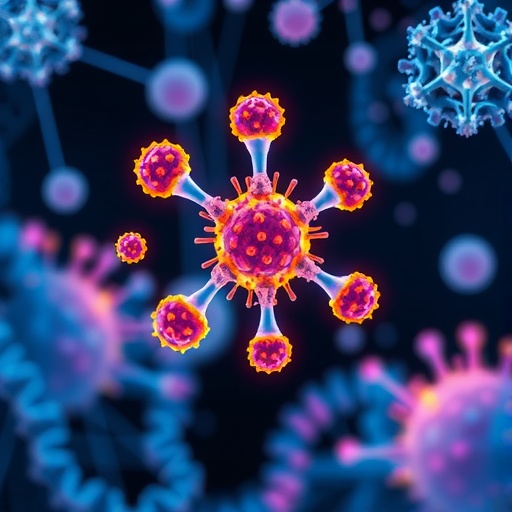
In a groundbreaking advance poised to redefine enzyme engineering, researchers at the University of Illinois Urbana-Champaign have unveiled a cutting-edge platform that seamlessly integrates artificial intelligence, automated robotics, and synthetic biology to enhance enzyme performance with unprecedented speed and precision. This innovative approach, detailed in a recent publication in Nature Communications, not only supercharges enzyme functionality but also democratizes access to complex protein engineering through an intuitive user interface. The implications of this work ripple across diverse fields, from sustainable energy production to pharmaceutical development.
Enzymes, the biological catalysts that drive countless metabolic and industrial processes, have long been heralded for their potential to revolutionize manufacturing and medicine. However, their widespread application remains constrained by intrinsic limitations in their catalytic efficiency and specificity. Traditional methods to overcome these barriers, typically grounded in trial-and-error mutagenesis or laborious directed evolution, are often time-consuming and inefficient. The Illinois team, led by Professor Huimin Zhao, recognized that the vast combinatorial space of possible protein mutations far exceeds conventional screening capacities, demanding a more sophisticated, data-driven approach.
Harnessing the power of artificial intelligence, the researchers developed an AI model capable of not only predicting enzyme function from amino acid sequences but also forecasting beneficial mutations that could enhance performance. The complexity of this task is staggering; for a typical enzyme, potential variants number beyond the count of atoms in the universe, rendering exhaustive experimental screening impossible. By employing machine learning algorithms trained on extensive datasets of known enzyme structures and activities, the model intelligently narrows the search to a manageable library of high-potential variants.
.adsslot_ZyVMaGTceP{width:728px !important;height:90px !important;}
@media(max-width:1199px){ .adsslot_ZyVMaGTceP{width:468px !important;height:60px !important;}
}
@media(max-width:767px){ .adsslot_ZyVMaGTceP{width:320px !important;height:50px !important;}
}
ADVERTISEMENT
Yet, AI alone cannot close the loop. To translate computational insights into tangible biochemical improvements, Zhao’s team leveraged the iBioFoundry, an advanced automated synthetic biology facility that they direct. This state-of-the-art platform integrates robotic systems for rapid protein synthesis with high-throughput functional assays, enabling swift experimental validation of AI-predicted enzyme variants. Following each round of synthesis and testing, experimental data feed back into the AI, refining its predictive accuracy in a cyclical process reminiscent of a self-improving laboratory.
This iterative framework effectively transforms the iBioFoundry into a “self-driving” lab, wherein the design, construction, and evaluation of enzymes occur autonomously. Stephan Lane, manager of the iBioFoundry and co-lead author, describes this synergy: “The design and learning process is handled by AI algorithms, while the building and testing are executed by robotic systems.” Such integration accelerates the innovation cycle exponentially, drastically cutting the time needed to optimize enzyme properties.
Applying this novel platform, the team targeted two industrially significant enzymes with remarkable results. One enzyme, widely used as an additive in animal feed to enhance nutritional availability, exhibited a staggering 26-fold increase in catalytic activity after optimization. Meanwhile, a second enzyme critical to chemical synthesis systems demonstrated a 16-fold boost in activity coupled with a 90-fold enhancement in substrate specificity. The latter improvement signifies the enzyme’s greatly reduced propensity to engage with off-target molecules, a crucial advance for industrial processes demanding high selectivity.
Crucially, the researchers emphasize that their technology is not confined to these two enzymes. The platform requires only the protein’s amino acid sequence and an assay assessing its function, making it broadly applicable to a diverse spectrum of enzymes across biological domains. This flexibility holds promise for accelerating breakthroughs in fields including renewable energy, biopharmaceutical manufacturing, and environmental remediation.
To facilitate widespread adoption, the team developed a user-friendly interface that allows researchers without computational expertise to leverage the power of AI-based enzyme engineering. Graduate student Tianhao Yu explains, “Users can interact with the system via simple English queries, eliminating barriers posed by programming languages like Python.” This accessibility democratizes enzyme optimization, empowering scientists from varied disciplines to harness sophisticated bioengineering tools effortlessly.
Looking ahead, the researchers aim to refine their AI algorithms further and enhance their laboratory automation capabilities, pushing the boundaries of throughput and precision. The vision is a fully autonomous system that iteratively designs and fabricates custom enzymes on demand, potentially revolutionizing how biotech innovations are conceived and realized. This trajectory aligns with broader trends toward integrating AI and robotics in life sciences, heralding a new era of accelerated discovery.
Support for this pioneering work comes from major funding agencies, including the National Science Foundation and the U.S. Department of Energy, underscoring the strategic importance of enzyme engineering in addressing global challenges. By fusing artificial intelligence with synthetic biology in a robust, scalable platform, the University of Illinois team has not only set a new standard for enzyme design but also opened the door to transformative applications across science and industry.
In sum, this research encapsulates a transformative advance in biotechnology. Through an elegant fusion of AI prediction, robotic synthesis, and rapid functional testing, the team has established a generalized, autonomous method for enzyme improvement. Its impact promises to resonate across sectors, fostering innovations that enhance efficiency, sustainability, and therapeutic efficacy. As the boundaries between computation and biology increasingly blur, such platforms will undoubtedly accelerate the pace of scientific breakthroughs for years to come.
Subject of Research: Not applicable
Article Title: A generalized platform for artificial intelligence-powered autonomous enzyme engineering
News Publication Date: 1-Jul-2025
Web References:
https://www.nature.com/articles/s41467-025-61209-y
References:
Zhao, H. et al. A generalized platform for artificial intelligence-powered autonomous enzyme engineering. Nature Communications, 2025. DOI: 10.1038/s41467-025-61209-y
Keywords
Artificial intelligence, enzyme engineering, synthetic biology, protein design, automated robotics, iBioFoundry, catalytic activity, substrate specificity, high-throughput screening, autonomous laboratory, machine learning, biotechnology
Tags: accelerating metabolic process efficiencyAI-driven biological catalyst developmentAI-powered enzyme engineeringautomated enzyme performance enhancementautonomous robotics in biotechnologydemocratizing protein engineering accessimplications of enzyme engineering in pharmaceuticalsinnovative platforms for enzyme researchmachine learning for protein optimizationsustainable energy enzyme applicationssynthetic biology advancementstransformative applications of enzymes





